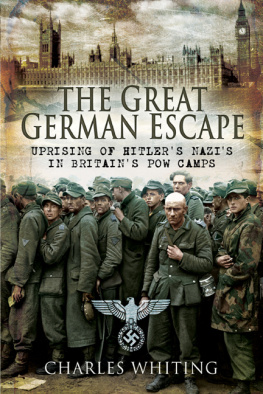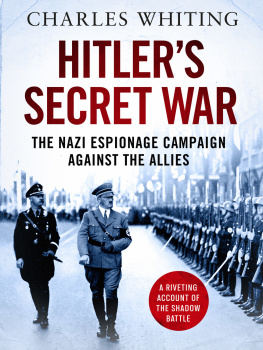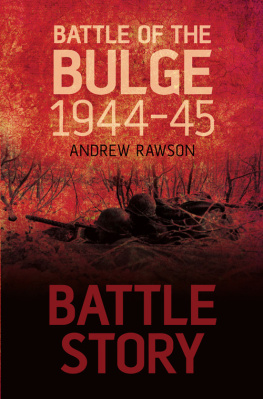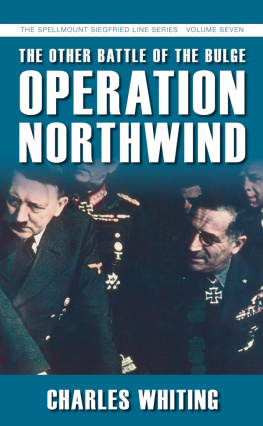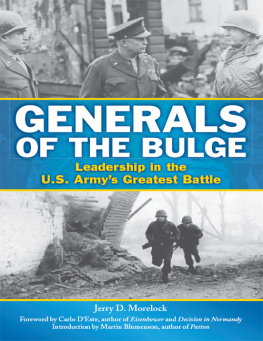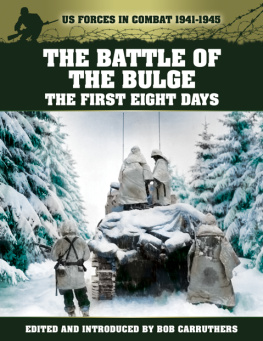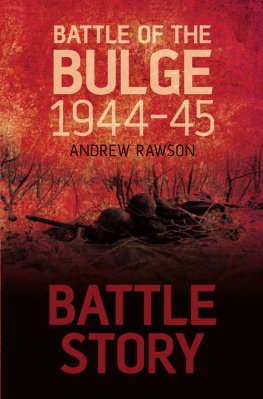Charles Whiting - The March on London: Covert Operations in the Battle of the Bulge December 1944
Here you can read online Charles Whiting - The March on London: Covert Operations in the Battle of the Bulge December 1944 full text of the book (entire story) in english for free. Download pdf and epub, get meaning, cover and reviews about this ebook. year: 1996, publisher: Combined Books, genre: History. Description of the work, (preface) as well as reviews are available. Best literature library LitArk.com created for fans of good reading and offers a wide selection of genres:
Romance novel
Science fiction
Adventure
Detective
Science
History
Home and family
Prose
Art
Politics
Computer
Non-fiction
Religion
Business
Children
Humor
Choose a favorite category and find really read worthwhile books. Enjoy immersion in the world of imagination, feel the emotions of the characters or learn something new for yourself, make an fascinating discovery.

- Book:The March on London: Covert Operations in the Battle of the Bulge December 1944
- Author:
- Publisher:Combined Books
- Genre:
- Year:1996
- Rating:4 / 5
- Favourites:Add to favourites
- Your mark:
- 80
- 1
- 2
- 3
- 4
- 5
The March on London: Covert Operations in the Battle of the Bulge December 1944: summary, description and annotation
We offer to read an annotation, description, summary or preface (depends on what the author of the book "The March on London: Covert Operations in the Battle of the Bulge December 1944" wrote himself). If you haven't found the necessary information about the book — write in the comments, we will try to find it.
Charles Whiting: author's other books
Who wrote The March on London: Covert Operations in the Battle of the Bulge December 1944? Find out the surname, the name of the author of the book and a list of all author's works by series.
The March on London: Covert Operations in the Battle of the Bulge December 1944 — read online for free the complete book (whole text) full work
Below is the text of the book, divided by pages. System saving the place of the last page read, allows you to conveniently read the book "The March on London: Covert Operations in the Battle of the Bulge December 1944" online for free, without having to search again every time where you left off. Put a bookmark, and you can go to the page where you finished reading at any time.
Font size:
Interval:
Bookmark:
THE MARCH ON LONDON
COVERT OPERATIONS IN THE BATTLE OF THE BULGE DECEMBER 1944
CHARLES WHITING
First published in 1992 by LEO COOPER
Also published as The Great German Escape by Pen & Sword ltd
This edition published by Bookzat Publishing 2018
Copyright Charles Whiting 1992
Another aspect of the Germans thorough plans was the amazing scheme, somehow transmitted to Britain, for a break by all German prisoners of war. By all odds the most Wellsian phase of the German war of nerves, it has still not been completely explained. We do know that German prisoners began organizing for a mass break; that they plotted to seize arsenals, obtain tanks and actually prepare the way for German landings in England.
Captain Robert Merriam (official historian to the US Ninth Army in the Second World War)
No escape story of the Second World War was more daring in concept, more fantastic, more ambitious, more hopelessly fanatical than that of the prisoners of Devizes. It began with a bold master-plan for a mass break-out of German POWs from prison camps in wartime Britain.
Colonel Alexander Scotland (head of the British POW Interrogation Service in the Second World War)
ACKNOWLEDGEMENTS
The author would like to thank the following individuals and institutions for the great assistance they have given him with this book: Mr R. Brinkworth; Mrs M. Charles; Mr R. Dyke; Mrs L. Painter (Devizes); Mr R. Beckton; Mr A. Stewart (Sheffield); Mr A. Jacques (Eden Camp, Malton); the various gentlemen of The Old Prisoner-of-War Camp, Thirkleby, North Yorkshire; Mr T. Dickinson of the New York City Public Library System; Kreisverwaltung Monschau, Germany; Mil. Forschungsamt, Freiburg i.B, Germany; Monseiur Fagnoul, St Vith, Belgium; plus the Manchester Evening News.
They are not fools, however much we try to persuade ourselves to the contrary. But supposing they had got some tremendous sacred sanction some holy thing, some book or gospel something which would cast over the whole ugly mechanism of the German war the glamour of the old torrential raids.
John Buchan
In March, 1945, with only two months of the war to run, some sixty British, French and Belgian officers, plus one Pole, were kicking their heels impatiently at Dormie House at Wentworth, the mock-Tudor premises of Sunningdale golf course. They were all highly experienced members of the SOE, (Special Operations Executive) who had parachuted into Occupied Europe repeatedly to organize resistance to the Germans. The women among them had set up escape routes and had acted as wireless operators. Others had kidnapped a German general in Crete, smuggled arms into Albania, transported V-l and V-2 secrets right across Germany back to Britain. Most of them wore the bright upturned wings and parachute of men and women who had made three or more operational jumps into enemy territory.
A week or two before, the authorities had become alarmed at the fate of Allied POWs in German hands. In London, they knew from the MI9 network in POW camps that the Germans had moved the great majority of British and American prisoners to the narrow section of land in Central Germany still under Nazi control. From there the POWs, according to their own secret reports back home, expected to be moved to the Bavarian and Austrian Alps, where it was assumed that the fanatical Nazi rearguard would make its last stand.
In particular, the Allied authorities were worried about the fate of the Prominenten, as the Germans called their most important prisoners. What would the Nazis do with them when they realized the war was lost? Would they use them to blackmail the victorious Allies into concessions? Or would they shoot them out of hand as a last act of spite? Allied Intelligence already knew that Hitler had declared vehemently, Erschiesst sie alle! (Shoot the lot of them).
Now, as the Allies prepared to cross the Rhine and write the final chapter in the history of Hitlers vaunted Thousand-Year Reich, the authorities agonized over the problem of the Prominenten. They included an American ambassadors son, a senior US air force general, Earl Haigs only son, a close relative of Field-Marshal Alexander and the nephew of King George VI himself, the present Lord Harewood. Could they let people of such importance be shot by the Nazis?
In the first week of that March, the authorities decided they couldnt. Hastily an irregular force called the Special Allied Airborne Reconnaissance Force (SAARF) was set up. Under the command of a fierce brigadier of formidable demeanour, known behind his back as Crasher, SAARF was to consist of twenty three-man teams: an officer, an NCO and a signaller with an easily hidden transmitter set. When the time came, each team would set off from the nearby airfield to be dropped after dark near its target prisoner-of-war camp. Dressed in tattered uniforms, they would hide in the nearest wood, spy out the land, and then join an Arbeitskommando, a POW working party. When the Arbeitskommando returned to camp in the late afternoon, they would go with it and report to the SBO, the Senior British Officer in the camp. With his help they would open up radio contact with the nearest Allied troops. These would then paradrop arms and supplies to the POWs, while the air force gave air cover, flying over the camp until the POWs had subdued their guards and taken control. Then it would be up to the armed POWs to defend themselves against any German attempt to cart them off to the National Redoubt in the Bavarian and Austrian Alps.
Captain Patrick Leigh Fermor, one of the most experienced members of the SAARF unit, was given permission to break the secrecy of the operation to interview Colonel Miles Reid, who had not long been repatriated from Colditz, where many of the Prominenten were imprisoned.
Colonel Reid exploded. Had we heard nothing of the impregnability of the fortress, no idea of the thoroughness and the rigour of the checks and counter-checks? There was absolutely no hope of the plan succeeding. We would all be goners.*
* Introduction by Patrick Leigh Fermor to Into Colditz by Miles Reid, Michael Russell, 1983.
The next day Colonel Reid went to see the brigadier-in -charge of the airborne operation. A long and heated discussion followed. Bitter words were exchanged. They both emerged scowling, Leigh Fermor recalled years afterwards. He watched stony-faced as Colonel Reid snorted angrily at the red-faced brigadier: Ill go to Churchill if its necessary!
In the end the scheme was called off. The Allies were already beginning to overrun the POW camps in Germany. Instead of trying to shoot their prisoners, the German guards were fleeing before the Allied advance and leaving the POWs to liberate themselves. SS Obergruppenfuhrer Gottlob (Praise God) Berger, head of the German POW system, whom one of his Prominenten prisoners described as more venal than fanatic, had decided by then to save his own skin. He wouldnt shoot them as Hitler had ordered.
So the threat was averted. The SAARF never did go into action. But if the threat had not been averted by events and by Bergers desire to wheedle himself into Allied good graces while there was still time, there would have been little chance of Colonel Reid being able to change Churchills mind about the operation. The Prime Minister would have ordered it to go ahead, despite all the dangers, for he knew something that none of the others involved in the SAARF scheme knew. A similar plan for prisoners-of-war to arm themselves and take over their camps, with support from an airborne operation, had been conceived three months before in the heart of the Empire and it had very nearly succeeded.
In that winter of 1944 when Allied authorities had thought that Hitlers Reich was on its knees one more blow and it would collapse the Germans achieved a surprise which was superior to any of the Intelligence coups which the Allies pulled off in the Second World War. Naturally the Anglo-Americans, particularly the British, were proud of those great deception schemes, Bodyguard, Fortitude, the Double-Cross scheme, etc, with which they fooled the Germans about Allied intentions. But between October and December, 1944, the Germans were able to raise, train and emplace a massive assault army of 600,000 men with all their equipment, not twenty-odd miles across the English Channel, as had been the case with Allies before D-Day, but a mere two hundred yards away on the other side of the front line in the Belgian Ardennes.
Font size:
Interval:
Bookmark:
Similar books «The March on London: Covert Operations in the Battle of the Bulge December 1944»
Look at similar books to The March on London: Covert Operations in the Battle of the Bulge December 1944. We have selected literature similar in name and meaning in the hope of providing readers with more options to find new, interesting, not yet read works.
Discussion, reviews of the book The March on London: Covert Operations in the Battle of the Bulge December 1944 and just readers' own opinions. Leave your comments, write what you think about the work, its meaning or the main characters. Specify what exactly you liked and what you didn't like, and why you think so.

